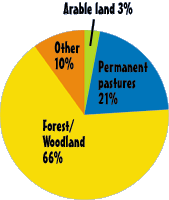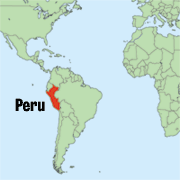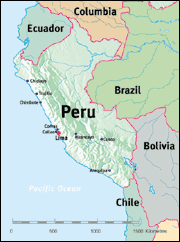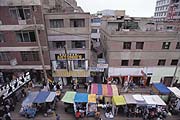| |
| Indicators | Peru | UK |
| (area km2) | 1,285,220 | 244,100 |
| People | | |
| Human Development Index (HDI) | 80th (of 174) | 10th |
| Population (millions) | 24.8 | 58.5 |
| Population density (per km2) | 19.3 | 244.0 |
| Urban population (%) | 72.0 | 89.3 |
| Life expectancy (years) | 68.6 | 77.2 |
| Infant mortality (per 1000) | 43.0 | 6.0 |
| Education | | |
| Adult literacy (%) | 89.2 | 99.0 |
| In primary education (%) | 93.8 | 99.9 |
| Economic, Health & Social | | |
| GNP (US$ per capita) | 63.7 | 21,410 |
| GNP annual growth rate (%) | 5.8 | 1.9 |
| TV's (per 1000 people) | 144 | 647 |
| PC's (per 1000 people) | 18 | 263 |
| Daily calorie intake | 2,302 | 3,276 |
| Doctors (per 1000 people) | 0.73 | 164 |
|

Introduction
Peru is as large as the combined area of the United Kingdom, France and Spain. It is the third largest country in Latin America and has extreme geographical features with human habitation very difficult in places.
The long Pacific coast is virtually desert. The Andes rise steeply from a narrow coastal shelf. The high plateau of the mountains has towering snow-covered peaks and deep canyons. The forested Andean slopes become more gentle towards the east, and further still, towards Brazil and Colombia, the rainforest of the Amazon begins.
Main industries:
mining of metals,
petroleum,
fishing,
textiles,
clothing,
food processing,
cement,
auto assembly,
steel,
shipbuilding,
metal fabrication
Main export commodities:
copper,
zinc,
fishmeal,
crude petroleum and byproducts,
lead,
refined silver,
coffee, cotton

|
|






